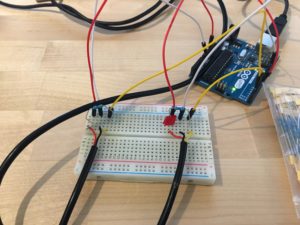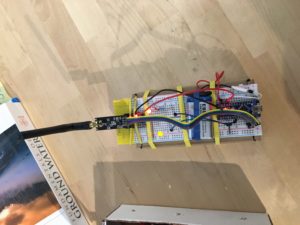I started my internship at the University of Utah this week. I’m working with the Carbon Science and Engineering Research Group, lead by Dr. Brian McPherson. One of the major subjects of research of this group is carbon sequestration, a way to store CO2 underground so it doesn’t get into the atmosphere.
The week started on Sunday with a drive up to Salt Lake City, and me and my fellow intern, Andrew, getting settled in at our lodging. The next day, we went to the University to get the necessary paperwork filled out. Then we met with the group, who gave us an introduction into the work we’ll be doing, as well as an introduction to all the team members. This included an introduction to Charlie, a high schooler from Salt Lake City who is also interning here; we will be working together.
Our main task will be helping to create a network of CO2 sensors that can transmit their data live to a computer, which can then map out where the CO2 is. This is important for carbon sequestration, because CO2 can leak from the ground, and it’s important to be able to detect where the leaks occur and how much is leaking.
Mostly, we will be working with Adriann, an undergrad student who is working on the sensor network, and to a lesser extent, Aaron, a researcher who is currently working on using a relatively expensive setup to measure the CO2 from a Panda Express vent on the roof of the Student Union. The idea is for the sensors to be relatively cheap, so you can have a lot of them and get data for the entire field where you’re storing CO2
Tuesday, we received a crash course in Python, a programming language often used for scientific purposes, as well as an introduction to Arduino, and how you can set up circuits and then control them with code. On Wednesday, there was a team meeting, followed by every team member giving us a presentation on the research that they are doing and that they have done. It was very interesting, but it was also quite the firehose of info.
On Thursday, I worked on an assignment from Aaron: write a program in Python that would take data from a certain form of text file, remove all the extraneous information, and then graph the data we are interested in. With the help of Google, I was able to make the program cull the extraneous information easily, but the graphing was harder, primarily because the file I was working from had 70,000 data points, so it would take a really long time to actually display the graph, which is a fairly important aspect of making a graph. I resolved the problem by averaging every 100 data points together, to reduce it to 700 data points, which were easily graphed.
Friday, Adriann had Andrew, Charlie, and I test the range of transmission. He had two Arduino boards set up, one transmitting and one receiving. When the receiver was receiving the transmissions, the LED would flash. When it wasn’t, it wouldn’t shine at all. We tested the range by putting the transmitter as high up on the roof of the Student Union as we could, and then walking in a straight line away from the Union. We marked on a map where it began to lag and pause between flashes, where the pauses reached 5 seconds long, and where it stopped receiving transmissions. We did this in four directions, so we got a bit of a hike.
Over the weekend, I relaxed and read some of the books I brought with me to Salt Lake, and quietly celebrated my 16th birthday. One interesting thing Andrew and I did was eat at the Pie Pizzeria, which had massive pizza slices, that were a bit too much for me. We had quite a bit of leftovers.




There are no comments published yet.